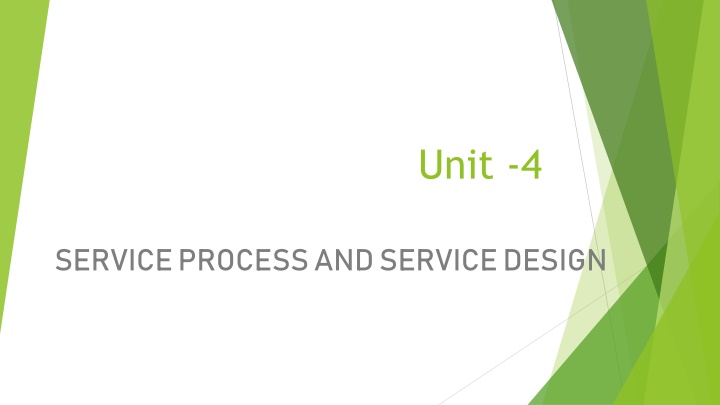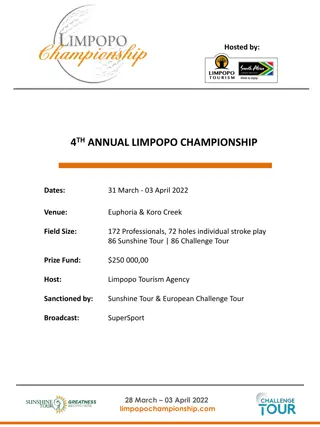
Service Processes and Design
Dive into the world of service processes and design, exploring the meaning of processes, classification of service operating systems, the degree of customer contact, policies, and flowcharting. Learn how to balance supply and demand effectively.
Download Presentation

Please find below an Image/Link to download the presentation.
The content on the website is provided AS IS for your information and personal use only. It may not be sold, licensed, or shared on other websites without obtaining consent from the author. If you encounter any issues during the download, it is possible that the publisher has removed the file from their server.
You are allowed to download the files provided on this website for personal or commercial use, subject to the condition that they are used lawfully. All files are the property of their respective owners.
The content on the website is provided AS IS for your information and personal use only. It may not be sold, licensed, or shared on other websites without obtaining consent from the author.
E N D
Presentation Transcript
Unit -4 SERVICE PROCESS AND SERVICE DESIGN
MEANING MEANING Process in services refers to the actual procedures, mechanisms and flow of activates by which the service is delivered- the service delivery and operating systems. In fast food outlets the process comprises buying the coupons at one counter and piking up the food against that at another counter.
CLASSIFICATION OF SERVICE OPERATING SYSTEMS Service operating system may be classified in a number of ways. Two considered here for illustrative purposes are according to: A) Type of process B) The degree of contact A) Type of process a) Line operations - service delivery passes through a number of processes before finalizing the transaction. b) Job shop operations-This type of service model provides customer satisfaction by tailoring the service to the client s needs. For example, a professional organization such as a law firm C) Intermittent operations-Some service projects are unique and seldom repeated. For example, construction projects or branding initiatives would fall under this category
THE DEGREE OF CONTACT a) High contact systems are more difficult to control since the customer can make an input to the process or even disrupt the process; (b) In high contact systems the customer can affect the timing of demand and it is more difficult to balance the capacity of the system to meet demands placed upon it; (c) Workers in high contact systems can have a great influence upon the customers view of the service provided; (d) In high contact systems production scheduling is more difficult; (e) It may be more difficult to rationalize high contact systems (e.g. by substituting technology); (f) It may be beneficial to separate high contact and low contact elements of a service system and encourage staff specialization in these different functions because of the varying skills required.
POLICIES POLICIES AND AND FLOWCHARTING FLOWCHARTING What steps are involved in the process? Are they arranged logically? Can some steps be eliminated or combined? Are the capacities of each step balanced? Where are customers involved in the process? Can unnecessary customer contact be reduced or eliminated? Can technology be used to speed up the process? Can some steps in the process be transferred elsewhere?
BALANCING SUPPLY AND DEMAND Inventory possible(e.g.spare capacity,people,etc) wherever Have favourable environment customer wait in Schedule workers according to demand( e.g.shift part-time employee) Schedule appointment systems) customers( e.g. working, Subcontract work to other service organisatons Provide substitute goods or services (e.g. automatic tellers) Have routines (e.g.only do essential jobs) Increase participation in the production process(e.g. self-service) peak-time efficiency Diversity counter seasonal markets) demands(e.g.enter customer Turn customers away during peak demand differential pricing) period (e.g. Share services/facilities with other service organisations Use marketing to shift demand (e.g. advertising campaigns) Improve system(e.g. where possible) the use service technology Change customer expectations of service (e.g. through usage)
THE PURCHASE PROCESS FOR SERVICESS Seeking information from respected personal sources (family, friends, peers) Relying on a firm with a good reputation Looking for guarantees and warranties Visiting service facilities or trying aspects of the service before purchasing Asking knowledgeable employees about competing services Examining tangible cues or other physical evidence Using the Web to compare service offerings One strategy to help reduce the risk perceived by customers is to educate them about the features of the service, describe the types of users who can most benefit from it, and offer advice on how to obtain the best results
What is Service Design? Service design is a process in which the designer focuses on creating optimal service experiences. This requires taking a holistic view of all the related actors, their interactions, and supporting materials and infrastructures. Service design often involves the use of customer journey maps, which tell the story of different customers interactions with a brand, thus offering deep insights.
Marc Stickdorn and Jakob Schneider, authors of the bestselling book This is Service Design Thinking, provide five basic principles that underlie service design: 1.User-centered, through understanding the user by doing qualitative research 2.Co-creative, by involving all relevant stakeholders in the design process 3.Sequencing, by partitioning a complex service into separate processes 4.Evidencing, by visualizing service experiences and making them tangible 5.Holistic, by considering touchpoints in a network of interactions and users




















